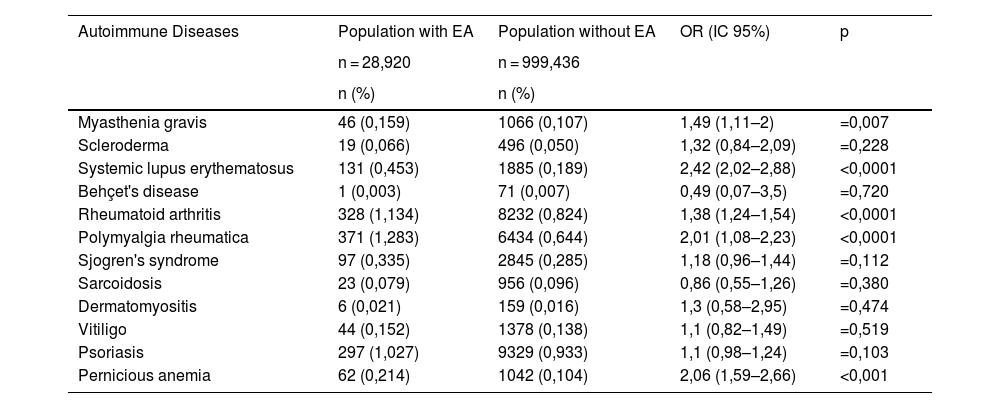The objective is to analyze the prevalence of Alzheimer's disease in patients with and without a diagnosis of different autoimmune diseases and the possible association between both pathologies.
Patients and methodsA multicenter, retrospective, cohort study was conducted to study the prevalence of Alzheimer’s disease among patients diagnosed with various autoimmune diseases compared to the general population. Data from electronic medical records from the Castilla-La Mancha healthcare system were analyzed using Natural Language Processing through the Savana Manager® artificial intelligence clinical platform. A total of 1,028,356 patients were analyzed, including 28,920 individuals with Alzheimer's disease and 999,436 control patients.
ResultsOut of the 12 autoimmune diseases analyzed, 5 showed a significant association with Alzheimer's disease with p < 0.05. Myasthenia gravis had an increased prevalence of AD with OR 1.49 (95% CI 1.11–2), systemic lupus erythematosus with OR 2.42 (95% CI 2.02–2.88), rheumatoid arthritis with OR 1.38 (95% CI 1.24–1.54), polymyalgia rheumatica with OR 2.01 (95% CI 1.08–2.23), and pernicious anemia with OR 2.06 (95% CI 1.59–2.66). The remaining autoimmune diseases analyzed did not show a higher prevalence of Alzheimer's disease compared to the general population.
ConclusionsThere may be an association between certain systemic autoimmune diseases and Alzheimer's disease. Further studies are needed to confirm our findings, establish causality, and explore the underlying mechanisms of this association.
Analizar la prevalencia de la enfermedad de Alzheimer en pacientes con y sin diagnóstico de diferentes enfermedades autoinmunes y la posible asociación entre ambas patologías.
Pacientes y métodosSe plantea de un estudio retrospectivo de cohortes multicéntrico estudiando la prevalencia de la enfermedad de Alzheimer (EA) dentro de los pacientes diagnosticados de diversas enfermedades autoinmunes en comparación la población general. Para ello se han examinado datos de las historias clínicas electrónicas del sistema de salud de Castilla-La Mancha utilizando el procesamiento de Lenguaje Natural a través de la plataforma clínica de inteligencia artificial Savana Manager®. Se analiza un total de 1.028.356 pacientes, 28.920 individuos con EA y 999.436 pacientes control.
ResultadosDe las 12 enfermedades autoinmunes analizadas 5 mostraron asociación significativa con presentar enfermedad de Alzheimer con una p < 0,05. Presentaron mayor prevalencia de EA la miastenia gravis OR 1,49 (IC95% 1,11–2), el lupus eritematoso sistémico OR 2,42 (IC95% 2,02–2,88), la artritis reumatoide OR 1,38 (IC95% 1,24–1,54), la polimialgia reumática OR2,01 (IC95% 1,08–2,23) y la anemia perniciosa OR 2,06 (IC95% 1,59–2,66). El resto de enfermedades autoinmunes analizadas no presentaron una mayor prevalencia de EA que la población general.
ConclusionesPodía existir una asociación entre determinadas enfermedades autoinmunes sistémicas y la enfermedad de Alzheimer en pacientes con determinadas enfermedades autoinmunes sistémicas, si bien se necesitan nuevos estudios para confirmar nuestros hallazgos, establecer la posibilidad de causalidad y explorar los posibles mecanismos que subyacen a esta asociación.
Article
Diríjase desde aquí a la web de la >>>FESEMI<<< e inicie sesión mediante el formulario que se encuentra en la barra superior, pulsando sobre el candado.

Una vez autentificado, en la misma web de FESEMI, en el menú superior, elija la opción deseada.

>>>FESEMI<<<







